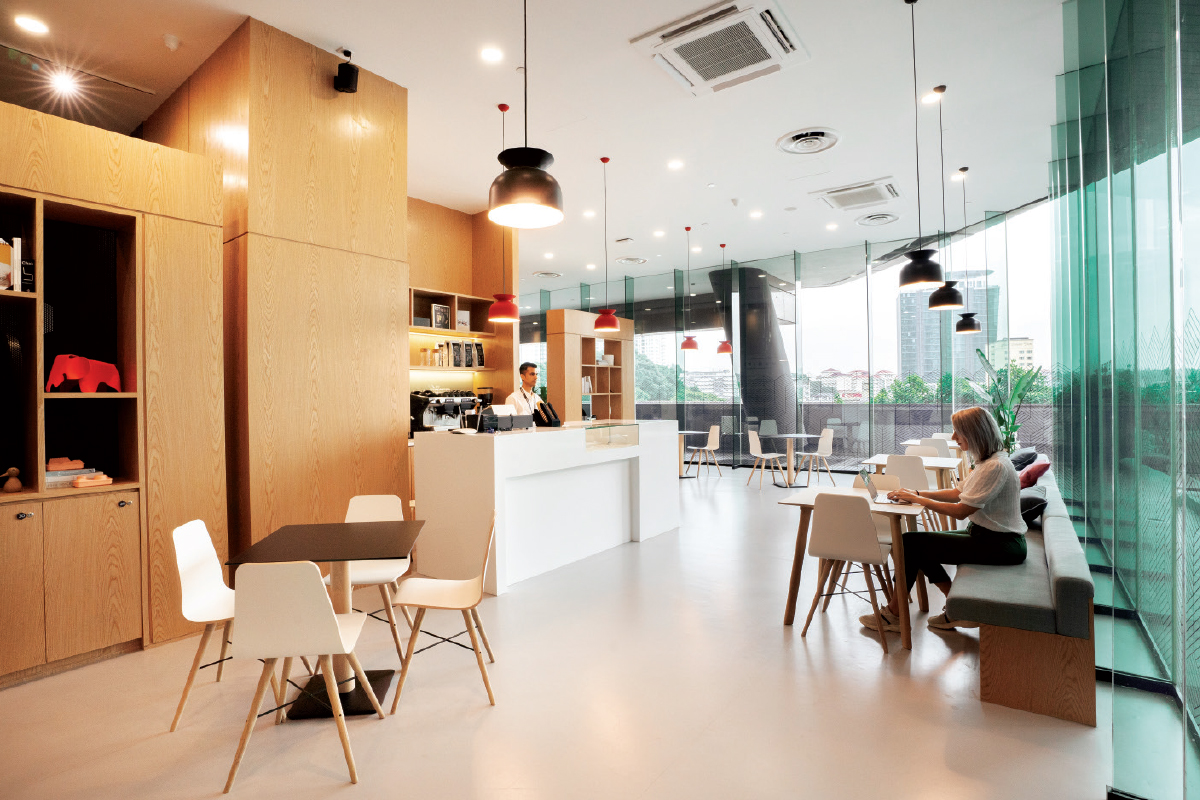
Market experts say the flexible office space market has been relatively active over the last year (Photo by Zahid Izzani/The Edge)
This article first appeared in City & Country, The Edge Malaysia Weekly on January 17, 2022 - January 23, 2022
The pandemic has brought about many changes and among them are the use of and demand for office space. According to JLL Property Services (Malaysia) Sdn Bhd country head YY Lau, the trends of right-sizing and space consolidation have been accelerated by the pandemic.
In an email interview, she says the new enquiries received during the height of the pandemic show that tenants are starting to look for more “short-term, flexible and move-in-ready options”. These spaces are said to benefit from the current flight-to-quality trend, largely owing to discounted rental rates and increased location availability in a soft market brought about by the pandemic.
“Businesses often use these flexible spaces as swing spaces (temporary spaces) while waiting for their new office location to be ready,” Lau explains, adding that flexible office spaces are workspaces that are designed to “enable a variety of different ways of working, with different locations to work from”.
IWG Malaysia country head Vijayakumar Tangarasan says the aim of flexible office spaces is to meet the needs of employees.
“[Flexible office spaces] can be easily rearranged to accommodate changing business objectives, or quickly scaled up and down to fit teams of different sizes. These kinds of dynamic office spaces are typically designed to be used in conjunction with flexible working arrangements to provide teams with the freedom to work where, when and how they want,” Vijayakumar says in an email interview.
He adds that flexible office spaces are different from traditional offices in the sense that they utilise remote work and flexible schedules, “which in turn helps engage and retain talented individuals and employee productivity”. Flexible office spaces also solve the problem of long commutes, as the options allow employees to alternate between working from home (WFH), at a nearby workspace and a central headquarters.
IWG offers collaborative workspaces that cater for start-ups, small and medium enterprises, and large multinationals. Its companies include Regus, Spaces, No18, Basepoint, Open Office and Signature.
Knight Frank Malaysia executive director of corporate services Teh Young Khean comments in an email that the fully-fitted nature of flexible office spaces grants occupiers the “agility to begin occupation quickly with less need for initial capex”. They also cater for a wide range of options, from one person right up to larger organisations.
“In Malaysia, co-working operators have several business models to explore with landlords — conventional lease deals, management models and revenue sharing models. Operators are now diversifying and exploiting new market niches. Occupiers can select from a centre offering top-tier services to more functional, budget-friendly options, depending on their needs,” he shares.
Positive sentiment towards flexible office spaces
According to all three market experts interviewed, the flexible office space market has been relatively active.
“Over the course of 2020 and 2021, the number of flexible-space operators has grown. Despite the consolidation of some underperforming centres, the operators continue to maintain a strong presence in the office market,” Teh says.
Going forward, Lau says businesses may start to consider flexible working arrangements as we emerge from the pandemic.
Teh notes that in 3Q and 4Q2021, there were active enquiries and a gradual recovery in the office market, as well as an improved take-up of flexible office spaces.
“As more companies transition from WFH arrangements, some corporate planners have found the hybrid working model to be a beneficial arrangement. This augurs well for the flexible office space segment as it grants corporations another option, [which is the ability] to implement the hybrid model efficiently,” says Teh.
Lau adds that there is a reduced demand from occupiers for physical spaces and an increased focus on virtual office products, which has put some downward pressure on rental rates.
“Several sectors have remained active throughout the pandemic, such as the e-commerce, cloud computing, logistics and pharmaceutical sectors. Occupiers within these industries have been actively acquiring new office space either in traditional offices or within co-working spaces,” she shares.
Vijayakumar says the flexible office spaces alleviate the Covid-19 challenges by allowing businesses to economise and rebuild post-pandemic through reduced real estate costs.
Lau elaborates that most investments into the flexible office space market are made by independent fund management companies and risk capital investors. JLL was aware that some operators were looking to take advantage of the soft market conditions and capitalise on the low rental rates to expand; however, nothing has yet to materialise.
The international sentiment is similar, she says, adding that hybrid schedules and the flexibility of work-near-home programmes appear to be promising elements of long-term corporate real estate strategies.
“We have found that demand for flexibility in lease terms is rising; thus, tenants are increasingly requesting expansion, contraction and termination options in leases and are favouring short-duration commitments as they await greater clarity in business conditions and workplace strategies. Corporates have listed short-term space needs, workforce mobility and capex savings as the leading motivations for choosing a flex space,” says Lau.
Teh says that flexible office spaces are complementary to conventional offices, adding that the former acts as “an incubator”, which in turn can lead to “new take-up of conventional office spaces”.
“It offers a lower barrier to entry for start-ups in good locations, which would otherwise be beyond reach in conventional terms. Likewise, it is also an option for established corporations to set up a new venture before progressing into a larger rollout,” he adds.
Expansion outside of KL city
The flexible office segment is expanding on the outskirts of Greater Kuala Lumpur. Vijayakumar believes this may be supported by hybrid working, which is now becoming the new work paradigm.
“Many employees have shared a desire to have a workplace closer to home. This has sparked the adoption of [the] hub and spoke [model], where [companies] mainly operate from the main office (hub) with further satellite offices or workspaces (spoke) for employees to have a professional place of work within reach of home,” he explains.
Lau says that the attraction of decentralised locations include their proximity to residential suburbs and the improving public transport network. She adds, however, that central locations still remain an attractive location for flexible office space operators.
Teh shares that while KL city was the initial focus of many co-working operators, growth has spilled over into KL fringe and Selangor in the past few years. Operators that already have an established presence in KL city are keen to expand their services and offer more options to their members, supported by the fact that KL fringe and Selangor are also highly populated and have established business and commercial centres.
“With the hybrid working model likely considered by many multinational companies, there is increasing focus and appeal for operators to consider setting up options in these locations, especially those that enjoy ease of connectivity via public transport links,” he adds.
Great potential
There are key reasons why tenants have been and are continuing to show interest in using flexible office spaces.
First is the lower cost. A pre-built, move-in-ready space can reduce initial out-of-pocket expenses, enable greater efficiency and potentially drive down total occupancy costs, says Lau.
Teh cites agility and flexibility as another key factor as it enables organisations to stay nimble and scale the workforce up or down depending on business needs and market conditions.
Lau adds that flexible office spaces help organisations “buy time” as they launch new initiatives, establish growth projections and develop longer-term space strategies.
Fourth, according to Lau, is innovation and collaboration. Flex arrangements foster innovation through increased employee interaction, exposure to new business concepts and cross-pollination of ideas. Employees also have a good opportunity to interact and potentially collaborate with other companies as each flexible office location would typically house more than one company.
“Tenants can easily access multiple centres offered by their respective co-working operator. [In addition,] tenants will continue looking for a better office location with many facilities and amenities such as a collaboration area, quiet corner, nursing room, and so on. [In the] post-Covid-19 world, greater consideration will be given to the staff’s mental well-being at work, which the facilities mentioned will be able to provide,” Teh shares.
Despite the positives, flexible office spaces have their drawbacks. Both Lau and Teh point out that the main disadvantage is the lack of privacy, as tenants share the spaces and facilities in a co-working environment.
“This becomes a core issue when dealing with confidential information or sensitive client engagements,” Lau says.
Teh adds: “Occupiers will lack personalisation in their company branding as they are sharing space with many different companies.”
Another disadvantage would be a lack of exclusivity, says Lau. “Flexible offices offer memberships with unlimited access to communal workspaces for all types of companies. They are designed for members to come and go, and even bring as many guests as they like, which can lead to overcrowded spaces and limited access to meeting rooms.”
However, Teh shares that co-working centres mitigate these disadvantages by providing private rooms and other measures for their tenants.
Lau advises tenants considering flexible office spaces to look carefully at the contracts and memberships they are considering.
“Are they short-, mid- or long-term contracts? How flexible are these contracts? [For instance,] in the event that the space needs to be surrendered, is it possible for the tenants to surrender the space back to the open market or would they need to keep the space with them until their lease term expires?”
Lau advises future tenants to also ask about allocations provided for renovation periods; the membership coverage or entitlement to the tenant when using the common or shared amenities; and whether the location is right for the company.
Vijayakumar opines that hybrid working is the way forward.
“Fixed lease offices have become an obstacle to this movement in recent years but working through a global pandemic has proven to businesses that remote working arrangements are here to stay. This is where the flexible office spaces come into play … and without being tied to a rigid lease, businesses can scale and expand into other areas according to their needs,” he adds.
Positive forecast for sector
JLL Malaysia foresees a bright future for the flexible office space sector in the post-pandemic world. According to Lau, a significant shift in flexible space operating models is anticipated for 2022 globally. Landlords are creating their own flexible space (or partnering with flexible space operators) and corporate occupiers are considering a greater footprint dispersal to meet workforce demand, as well as new working and living patterns.
“In Malaysia, this will likely be the case for older buildings as they attempt to attract tenants into their buildings by providing flexible or short-term options,” she says.
IWG forecasts a rise in co-working locations outside of major cities due to expected trends in workforce demography, technological change and evolving business practices, which will contribute more than US$254 billion to local economies in the next decade.
“If current trends towards regional flexible working continue, communities could see more than three million jobs created by 2029 — equivalent to a city the size of Buenos Aires,” Vijayakumar says.
Teh opines that landlords will take on a bigger role as joint-venture partners or direct owners of co-working spaces by incorporating flexible work spaces into their properties. He also says that more consolidation is likely for smaller players as they are acquired or pushed out of the market.
“[The flexible office space industry] is expected to grow at a more sustainable pace than in the last few years,” shares Teh, signifying that the sector is growing and is here to stay.
Save by subscribing to us for your print and/or digital copy.
P/S: The Edge is also available on Apple's App Store and Android's Google Play.
- China's DeepSeek says theoretical profit margin is 545% for its AI models
- MyDigital ID can now be used to access Sumbangan Tunai Rahmah portal, says IRB
- Norway PM plans to raise financial support for Ukraine
- No provision in Act 522 against 50-year-old practice of mixing imported and local white rice — ministry
- EPF’s strong performance reflects investor confidence in govt's growth-friendly policies — PM
- China's DeepSeek says theoretical profit margin is 545% for its AI models
- Norway PM plans to raise financial support for Ukraine
- No provision in Act 522 against 50-year-old practice of mixing imported and local white rice — ministry
- EPF’s strong performance reflects investor confidence in govt's growth-friendly policies — PM
- MyDigital ID can now be used to access Sumbangan Tunai Rahmah portal, says IRB






